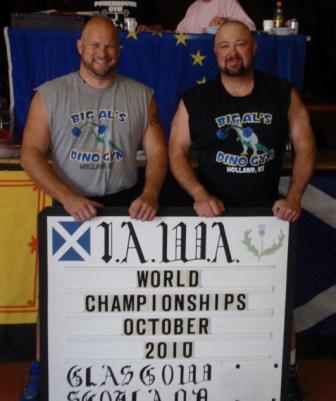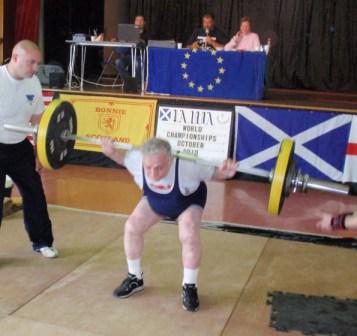Is the Lynch Formula Fair??
by Al Myers
There has been “lots of talk” regarding the Lynch Formula recently. Most of this centered around the fact that the Lynch Formula has just been expanded to contain factors for lifters that weigh over 138 kilograms. Now the Lynch Chart goes to 180 kilograms. The Lynch Formula has been the “adopted formula” of the USAWA and the IAWA since the early 90’s to calculate adjusted points in determining weight lifted to bodyweight comparisons in scoring. The Lynch Formula creator, Ian Lynch, developed and modified his formula to apply to the lifts done in All-Round Weightlifting. As far as I know, no other lifting organization uses the Lynch Formula. So, you could say, that we have a Formula that tailors to our specific lifting sport – All Round Weightlifting! I have never really heard the reasons how the Lynch Formula was derived. Most other weightlifting formulas are derived from a data set of numbers, usually records or performances of lifters of different bodyweights. I know this is how the Sinclair Formula was derived in Olympic Weightlifting. It has even been changed and modified over time when it is “re-evaluated” using new data, and new factors are created to maintain the fairest formula possible. However, this is easier to do when you are analyzing only two lifts (the Snatch and Clean and Jerk) than when you are looking at over 200 lifts, like we have in All-Round Weightlifting. I find it hard to believe that Ian Lynch used any data involving All-Round Lifts when he developed his formula. Afterall, what data involving All Round Lifting was available 20 years ago?
The big question always arises, is the Lynch Formula fair? I have several larger lifters in my gym who feel that it isn’t, and that the Lynch Formula favors the lighter lifter. But then I hear from light lifters who say it favors the heavier lifters. And when the fact is pointed out that the past several years the Overall Best Lifter at the IAWA World Championships has weighed over 105 kilograms, they have a good argument. I always try to be as open-minded as possible, and I like to have the FACTS before I form a hard opinion on something. This is why I performed my own self-study on this – to answer that question to myself. In no way is this information I am presenting you a scientific study that has any statistical significance. I am making that disclaimer LOUDLY, so my statistics friends like Tom Ryan (who is way smarter than me in matters like this) won’t point out my deficiencies in the methods of my study. This study is entirely just a compilation of data that must be taken on surface value. But it is still VERY INTERESTING and should provide the best factual support regarding the fairness of the Lynch Formula that has ever been available.
Study – Determining the Fairness of the Lynch Formula
Objective: The objective of this study is to evaluate the fairness of the Lynch Formula in regards to correction factors for bodyweight adjustments.
Design: The USAWA Record List will be used as the data source of information that will be evaluated. The USAWA record list has accumulated information on records in various lifts for over 20 years. Twenty lifts will be selected (the Heavy Lifts will be left out). The lifts selected will be the ones that have the most records established in them through all weight and age classes. Three weight divisions will be arbitrary selected – lightweight lifters (80 kilogram class and below), middleweight lifters (85-100 kilogram classes), and heavyweight lifters (105 kilogram class and above). The best record according to Lynch Formula will be selected from each weight division. These three divisions will then be ranked according to the best lifts according to the Lynch Points, and all points will be added up to determine which weight division has the best ranking, and thus assumed to receive the biggest advantage from the Lynch Formula.
Assumptions: Since individual bodyweights are not known from the USAWA Record List, the weight of the weight class will be used in calculating Lynch Points. Lifters in the 125 kg plus class will be assigned the Lynch Correction for 130 kilograms bodyweight. This may be an underestimate of the actual bodyweights of superheavyweight lifters, and if so, would provide numbers that would artificially elevate the lifts of SHW lifters in regards to Lynch Points (NOT an advantage for heavy lifters). Also, the assumption is made that the record lifts are representative of the average lifting ability of all lifters in these bodyweight classes. By picking the 20 lifts with the most records, it is assumed that these are the 20 all-round lifts that are performed the most, thus providing the best data base of numbers available from the Record List for evaluation.
Results:
| Lift | Lightweight
(80 K class and below) |
Middleweight
(85 K to 100 kg class) |
Heavyweight
(105 K class and above) |
| Bench Press
Feet in Air |
320# – Smith
(70K) LP – 320.0 points |
480# – Succarote
(100K) LP – 406.6 points |
441# – Meek
(125+K) LP – 327.2 points |
| Clean&Jerk
Right Arm |
132# – Zaremba
(75K) LP – 132.0 points |
160# – Bryan
(85K) LP – 148.4 points |
175# – Burtzloff
(125+K) 129.8 points |
| Clean&Press
Heels together |
226# – Hirsh
(80K) LP – 217.2 points |
248# – Bryan
(85K) LP – 230.0 points |
300# – Meek
(125+K) LP – 222.6 points |
| Cont Snatch | 220# – Waterman
(70K) LP – 229.9 points |
248# – Bryan
(85K) LP – 230.0 points |
265# – Ciavattone
(125+K) LP – 196.6 points |
| Continental
to Chest |
325#- Waterman
(70K) LP – 339.7 points |
380# – Anderson
(90K) LP – 431.1 points |
385# – Conners
(125+K) LP – 285.6 points |
| Continental
Clean&Jerk |
287# – Waterman
(70K) LP – 299.9 points |
320# – Bryan
(85K) LP – 296.8 points |
369# – Anderson
(105K) LP – 304.6 points |
| Cheat Curl | 190# – Gazda
(60K) LP – 220.8 points |
235# – Anderson
(90K) LP – 210.9 points |
260# – DelSignore
(105K) LP – 214.7 points |
| Deadlift
2 bars |
463# – McKean
(80K) LP – 445.0 points |
610#- Schrock
(100K) LP – 516.7 points |
600# – Myers
(115K) LP – 473.3 points |
| Deadlift
Heels together |
560# – Hirsh
(75K) LP – 560.0 points |
605# – Schrock
(100K) LP – 512.5 points |
650# – Myers
(125K) LP – 491.5 points |
| Deadlift
Rt Arm |
369# – McKean
(70K) LP – 385.6 points |
402# – Ullom
(100K) LP – 340.5 points |
562# – Ciavattone
(125+K) LP – 416.9 points |
| Deadlift
TrapBar |
600# – Hirsh
(80K) LP – 576.7 points |
635# – Schrock
(100K) LP – 537.9 points |
661# – Myers
(115K) LP – 520.9 points |
| Hack Lift | 670# – Hirsh
(80K) LP – 644.0 points |
605#- Anderson
(90K) LP – 543.0 points |
620# – Schrock
(105K) LP – 511.9 points |
| Jefferson
Lift |
702# – Hirsh
(80K) LP – 674.8 points |
601# – Schrock
(95K) LP – 523.5 points |
601# – Spayd
(105K) LP – 496.2 points |
| Pullover
& Press |
287# – Hirsh
(80K) LP – 275.9 points |
275# – English
(90K) LP – 246.8 points |
352# – Myers
(115K) LP – 277.4 points |
| Pullover
& Push |
331# – Crowe
(80K) LP – 318.2 points |
446# – Anderson
(90K) LP – 400.3 points |
474# – Burtzloff
(110K) LP – 382.0 points |
| Snatch
Rt Arm |
127# – Waterman
(70K) LP – 132.7 points |
160# – Bryan
(85K) LP – 148.4 points |
171# – Burtzloff
(110K) LP – 137.8 points |
| Front
Squat |
355# – Fleischer
(80K) LP – 341.2 points |
441# – Bruner
(95K) LP – 384.1 points |
495# – Meek
(110K) LP – 398.9 points |
| Steinborn | 325# – Monk
(70K) LP – 339.7 points |
375# – Schmidt
(100K) LP – 317.7 points |
441# – Ullom
(110K) LP – 354.6 points |
| Swing DB
Rt Arm |
120# – Smith
(75K) LP – 120.0 points |
120# – Schrock
(100K) LP – 101.7 points |
150# – Ullom
(110K) LP – 120.9 points |
| Zercher | 504# – Hirsh
(80K) LP – 484.4 points |
500# – Anderson
(90K) LP – 448.8 points |
529# – Moore
(120K) LP – 408.1 points |
NOTES: LP stands for Lynch Points.
Summary: Overall points were scored on placings with 1 point given for first, 2 points for second, and 3 points for third. These points were then “added up” to give total points for the 20 selected lifts, which would give the low overall score as being the best. The lightweight division had 40 points, the middleweight division had 38 points, and the heavyweight division had 42 points. The lightweight division had 6 “firsts”, the middleweight division had 8 “firsts”, and the heavyweight division had 6 “firsts”. Also, the Lynch Points were added for each division to give another comparison. The lightweight division had 7057.7 points, the middleweight division had 6885.7 points, and the heavyweight division had 6671.5 points.
What can be interpreted from all this??
The “total points” are really not that much different. A couple of points either way could easily be said to be an “acceptable tolerance”. All it would take is one of those records broken and it could “sway” back slightly the other way. The differences between the divisions (in regards to points) are not enough that anyone could make an argument one way or the other.
My opinion is that Ian Lynch was pretty much “right on” in regards to fairness to all bodyweights using his formula. Whether he did this using scientific calculations, or merely having “luck” in picking the right correction factors doesn’t really matter. The evidence of comparing the Lynch Formula to over 20 years of collected data in the form of USAWA records prove to me that his formula is very fair and one we should remain using. Of course, it is easy to pick out certain lifters that obscure the data due to their very exceptional lifting within their class. Bob Hirsh is a prime example as he greatly distanced himself from the others in the Hack Lift and Jefferson Lift. His Jefferson Lift record outscored the next lifter by over 150 Lynch Points, the biggest variation of all the lifts recorded in this data set. But there are other lifters in the middleweight and heavyweight classes who are “in a class of their own” also. Everything averages out. I was also concerned that the weight classes on the fringe of the lightweight and heavyweight classes (the 80 K and the 105K) would be overly represented, and thus tend to discredit the ranges I picked for this study. However, this was not the case as you can see from the results that the lighter lifters (70K and 75K), as well as the heaviest lifters (the 125+ lifters) were often represented as having the BEST lifts within their division. Only one 60K lifter made the list (this is not a largely represented class at meets), and he ended up having the BEST Lynch corrected Cheat Curl. Geoff Gazda’s 190# Cheat Curl in the 60K class outscored Antonio DelSignore’s 260# Cheat Curl in the 105 K Class, 220.8 points to 214.7 points. One 125+ K class lifter had the TOP Lynch Score among all divisions. Frank Ciavattone and his 562# One Arm Deadlift ranks above all the others.
I welcome any comments regarding this study of mine. You can either address them on the USAWA Discussion Forum or you can email me directly.



